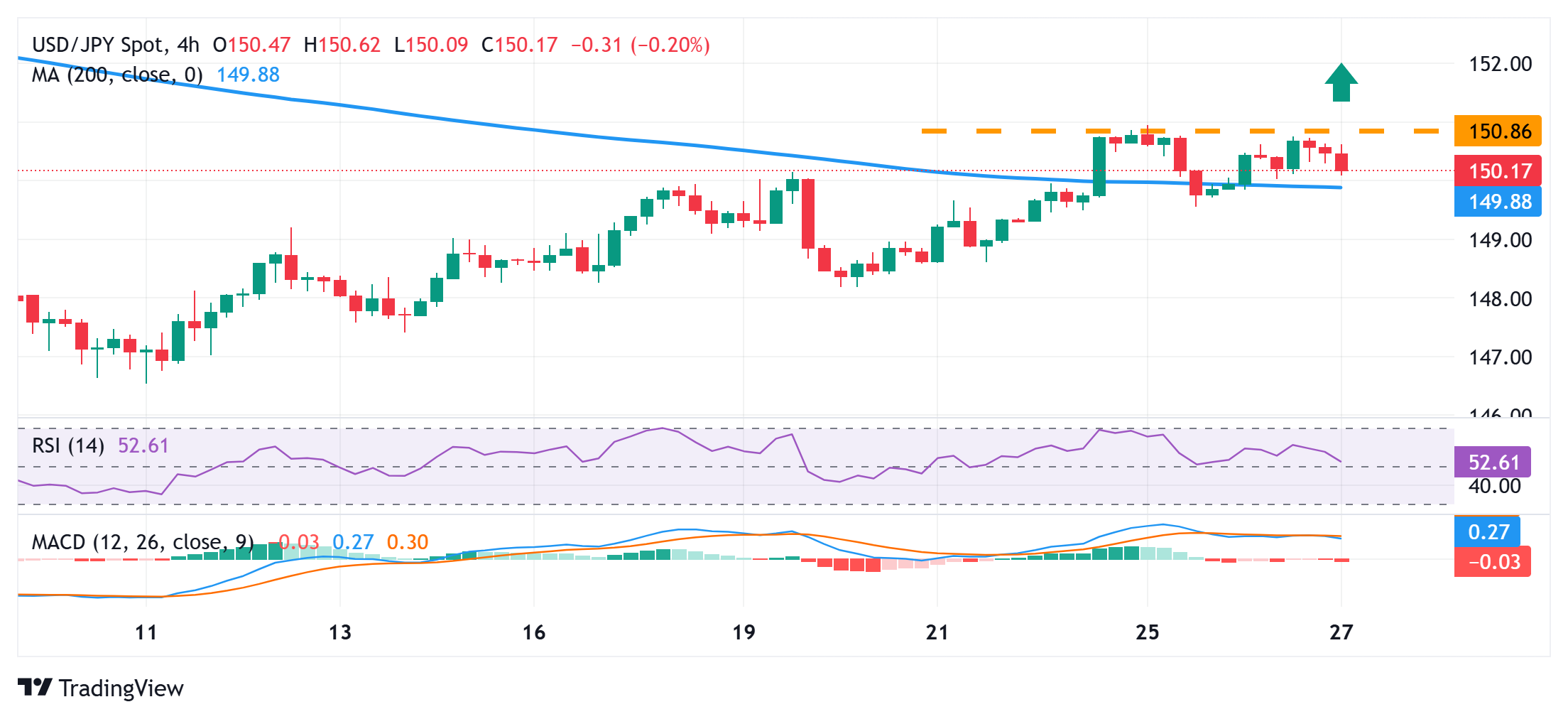USD/JPY sticks to intraday gains amid concerns about Trump’s trade tariffs
- The Japanese Yen attracts fresh buyers on Thursday amid rising trade tensions.
- Bets that the BoJ will continue raising rates lend additional support to the JPY.
- A modest USD pullback from a multi-week top also exerted pressure on USD/JPY.
The Japanese Yen (JPY) regains positive traction on Thursday as US President Donald Trump’s new tariffs on imported cars and light trucks starting next week boost demand for traditional safe-haven assets. Apart from this, the hawkish sentiment surrounding the Bank of Japan’s (BoJ) policy outlook, bolstered by strong wage growth for the third straight year, turns out to be another factor that underpins the JPY. Apart from this, the emergence of some US Dollar (USD) selling, drags the USD/JPY pair closer to the 150.00 psychological mark during the Asian session.
Meanwhile, the Federal Reserve’s (Fed) forecast for two 25 basis points rate cuts in 2025 marks a big divergence in comparison to hawkish BoJ expectations. This could result in a further narrowing of the US-Japan rate differential and support prospects for a further near-term appreciation for the lower-yielding JPY. Traders, however, might opt to wait for the Tokyo CPI and the US Personal Consumption Expenditure (PCE) Price Index on Friday before placing fresh directional bets. In the meantime, Thursday’s US macro data could provide some impetus to the USD/JPY pair.
Japanese Yen is underpinned by rising trade tensions and rising BoJ rate hike bets
- US President Donald Trump announced on Wednesday that he would impose 25% tariffs on all imported vehicles and foreign-made auto-parts on April 2, widening the global trade war. This comes on top of impending reciprocal tariffs against at least 15 countries next week and weighs on investors’ sentiment, boosting demand for the safe-haven Japanese Yen.
- Investors seem convinced that the Bank of Japan will continue raising interest rates amid expectations that strong wage growth would underpin consumption and filter into broader inflation trends. Adding to this, BoJ’s new board member Junko Koeda said on Wednesday that various indicators show underlying inflation moving towards 2% inflation sustainably.
- Meanwhile, the Federal Reserve revised its growth outlook downward amid the uncertainty over the impact of Trump’s trade policies and signaled that it would deliver two 25-basis-points interest rate cuts by the end of this year. This fails to assist the US Dollar to capitalize on its recent move higher to a three-week high touched during the Asian session on Thursday.
- Chicago Fed President Austan Goolsbee said in a Financial Times (FT) interview on Wednesday that it may take longer than anticipated for the next rate cut to come because of economic uncertainty. Goolsbee, however, believed that borrowing costs would be a fair bit lower in 12-18 months from now, though wait and see is the correct approach.
- Separately, Minneapolis Fed President Neel Kashkari reiterated that “we’ve made a lot of progress bringing inflation down, still there is still more work to do.” Kashkari acknowledged that the job market has stayed strong and that policy uncertainty is complicating the Fed’s job.
- St. Louis Fed President Alberto Musalem said that risks that inflation will stall above 2% or move higher in the near-term appear to have increased. If the labor market remains strong and second-round tariff effects become apparent, the US central bank may need to keep rates higher for longer or consider more restrictive policy, Musalem added further.
- The US Commerce Department reported on Wednesday that Durable Goods Orders rose 0.9% in February compared to the previous month’s revised increase of 3.3%. Moreover, Core durable goods, which strip out the volatile transportation sector, increased by 0.7%. The readings were better than consensus estimates and provided a modest lift to the USD Index.
- Thursday’s US economic docket features the release of the final Q4 GDP print, the usual Weekly Initial Jobless Claims data, and Pending Home Sales. The focus, however, will remain glued to the US Personal Consumption Expenditure (PCE) Price Index on Friday, which could provide some cues about the Fed’s rate-cut path and influence the USD price dynamics.
USD/JPY could attract dip-buyers; the 149.55 pivotal support holds the key for bulls

From a technical perspective, the USD/JPY pair’s inability to build on the recent breakout momentum above the 200-period Simple Moving Average (SMA) on the 4-hour chart and failure near the 151.00 mark on Tuesday warrant caution for bulls. That said, oscillators on the daily chart have just started gaining positive traction and support prospects for the emergence of some dip-buyers. Hence, any further weakness below the 150.00 psychological mark could find some support near the 149.55 area. Some follow-through selling, however, could make spot prices vulnerable to accelerate the fall towards the 149.00 mark en route to the 148.75-148.70 support. The latter coincides with the 100-period SMA on the 4-hour chart, which if broken might shift the bias in favor of bearish traders.
On the flip side, any positive move beyond the 150.50-150.60 region might continue to face hurdle near the 151.00 mark. This is followed by the monthly swing low, around the 151.30 region, which if cleared will set the stage for an extension of the recent recovery from a multi-month low. The subsequent move-up should allow the USD/JPY pair to aim towards reclaiming the 152.00 round figure.






